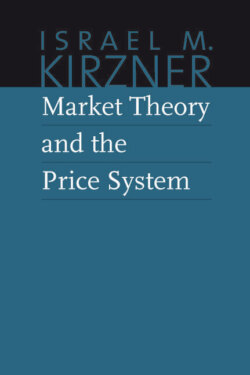Читать книгу Market Theory and the Price System - Israel M. Kirzner - Страница 46
На сайте Литреса книга снята с продажи.
The Paradox of Value
ОглавлениеModern utility theory emerged in the 1870s at the hands of Jevons, Menger, and Walras. One of the earliest uses of the theory was to sweep away a misunderstanding that had prevented the earlier classical economists from using the utility concept to explain prices.
The earlier writers found themselves unable to explain the prices of goods by reference to the use-value or utility of these goods. To be sure, the prices of many goods seem to reflect their relative degrees of usefulness to men; the classical economists would have welcomed such a theory. But they were troubled by the many goods whose prices seemed to defy any such explanation. Diamonds, for example, are clearly much less important for human life than water, yet the price of water is quite negligible compared with that of diamonds. This paradox had forced the classical economists to seek an entirely different method of explaining prices.
Marginal utility theory is able to dispose of the problem quite simply. The basis for the paradox was the premise that water is more significant for man than are diamonds. This premise is no doubt correct, but not in a way that can support the classical conclusions. Water, in the abstract, is no doubt more important than diamonds in the abstract. But for human action the greater importance of water over diamonds must be demonstrated through choice among alternatives. For an analysis of human action no other meaning can be attached to the term “more important.” From this point of view the greater importance of water must mean that we assume if a man has to choose between water and diamonds, he will choose water. But for the statement of alternatives a man must choose among, it is clearly insufficient to specify only that these are water and diamonds. One must specify the terms and conditions on which he is to choose. And here the irrelevance of the “greater importance of water over diamonds” for understanding their relative prices becomes immediately clear.
Water is more important than diamonds only where a man must choose between renouncing all water or renouncing all diamonds. Faced with such a choice it is indeed likely that a man will place diamonds distinctly in second place. But this kind of choice is one that the market does not confront the consumer with and therefore cannot have bearing on the determination of market prices. In the market a man buying or refraining from buying water is choosing not merely whether to have water or not to have water, but whether to have some additional quantity of water or not; and similarly, of course, for diamonds. Thus, the law of diminishing marginal utility provides the key.
The marginal utility of water cannot be said to be either higher or lower than that of diamonds until there are first specified (a) the size of the marginal unit and (b) the margin at which marginal quantities of water and diamonds are being compared. The marginal utility of water is indeed lower than that of diamonds—when a small quantity of water is compared with a similar weight of diamonds and when the loss of this small quantity of water would still leave the consumer with ample water. These are, in fact, the conditions under which consumers choose whether to buy water or diamonds. The quantity of water usually available is ample; thus, the margin at which an additional quantity of water is valued is such as to make its marginal utility low, according to the law of diminishing marginal utility. On the other hand, diamonds are usually possessed in sufficiently small amounts to ensure that the typically sized marginal unit still possesses high marginal utility.
If conditions were otherwise, prices would indeed reflect the altered conditions. If, for example, a thirsty owner of diamonds were to bargain in a desert with the owner of a quantity of water, we would indeed expect to find the price of water far from negligible. Clearly, in these circumstances, the marginal utility of water must be immensely higher than under normal conditions. Here, indeed, water would show itself as “more important for man than diamonds.”
